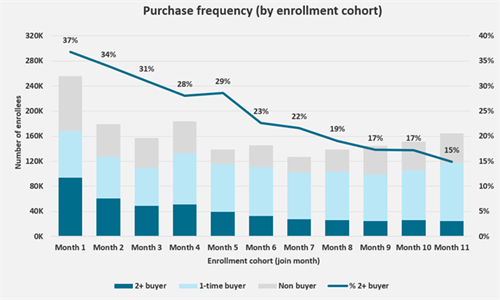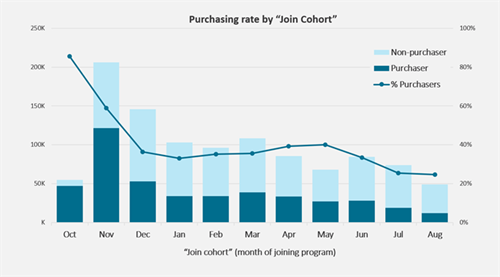WANT TO MAINTAIN THE RETURN ON LOYALTY® FROM YOUR LOYALTY PROGRAM? CONSIDER ITS AGE…

Launching a new or revitalised loyalty program is an exciting time for loyalty marketers. A chance to engage customers with a new value proposition, a shiny new budget to spend and if nothing else the sense of relief that something will actually be executed after all the meetings, planning and modelling.
But launches bring us face to face with the statistical joker of the loyalty deck; customer self-selection .
We have written before about this phenomenon. It is a fact that a brand’s most engaged and most valuable customers join new programs early and in the largest numbers. Joining early is economically rational for these customers as they stand to benefit most and they are more likely to notice the program adjacent to launch. Enrolments peak early and then taper off as high value customers sign up. If your business has seasonal peaks, you will also see enrolments increase in line with these sales ‘spikes’ as good customers visit to shop for Christmas or Mother’s Day.
Routinely we see early enrolment members; spending more, buying more frequently, redeeming more rewards, staying active longer, than later enrolees.
Typical views of enrolments in a new loyalty program

Later enrolments are overwhelmingly lighter buyers of your products, and as all brands have more light buyers the membership will ‘regress to the mean’ of customer value.
Note: at the end of the first program year, when we set out to measure the effectiveness of the money invested so far, we have a membership that is as full of high value customers, proportionally, as it ever will be. High value, engaged customers are over-represented in the early membership of all programs.
Measure your Return on Loyalty - early
Marketing investment in the early life of your program is much more likely to be to an engaged group of heavy buyers. These members are more likely to respond to your calls to action and buy even more / take up your offers. Response and conversion rates should be good, return on your loyalty spending great!
Bit like fishing in a barrel really.
Even by the end of the first year of operation, most programs are seeing a decrease in the number of new enrolees and a decrease in the average value of these latecomers. Smaller numbers of customers enrol each month but they keep coming and over time they dilute the high value customers who joined early.
Program aging: Time to get smarter with marketing investments
Later, investments that were very likely to reach a highly engaged customer are more likely to touch a customer that is only marginally interested and far less likely to respond to your offers.
A tangible example will help; program welcome packs sent to customers as they enrol are often effective at establishing program engagement but can be quite expensive. This expense produces good returns when it increases the loyalty of early-enrolling high value customers but is wasteful if extended to customers who are interested enough to enrol but lukewarm about consistent engagement with your brand.
Early joiners are more engaged and are more likely to purchase than later joiners

The importance of engagement scoring
Once your program membership reaches the distribution of customer values that mirrors your customer base generally, a mechanism that allows you to target customers most likely to appreciate and respond to your marketing allows you to maintain the heady ROL of the ‘early days’.
Customer engagement scoring is a subject worth an On Point paper of its own, but in the example of the Welcome Packs, a second or third purchase may be required before a member is considered sufficiently engaged to receive the full-blown card, samples and vouchers contained in the welcome-to-program kit.
We recommend all program operators prepare for member engagement scoring during the set-up and planning for program launch. Observing and noting how early cohorts of customers behave and interact differently with your program than later (lower value) cohorts will help identify what scoring elements are best at identifying members worthy of your investments – those who will help maintain your healthy ROL.
Implications
- You can invest in customers who enrol early with minimal risk that the money will be wasted on un-responsive customers
- The opposite is true as your program matures and enrollment rates fall
- Expect program ROL to fall after the initial enrolment ‘rush’, then level off unless you start targeting investment early
- Take advantage of good customer self-selection to build scoring strategies that allow you to discriminate positively for high value, engaged members when they are harder to find in the membership
- Program ROL can only be rigorously managed if measured
We are Ellipsis, the Customer Loyalty Experts. We help businesses thrive through solving complex customer problems. Please get in touch, we’d love to talk.
References






